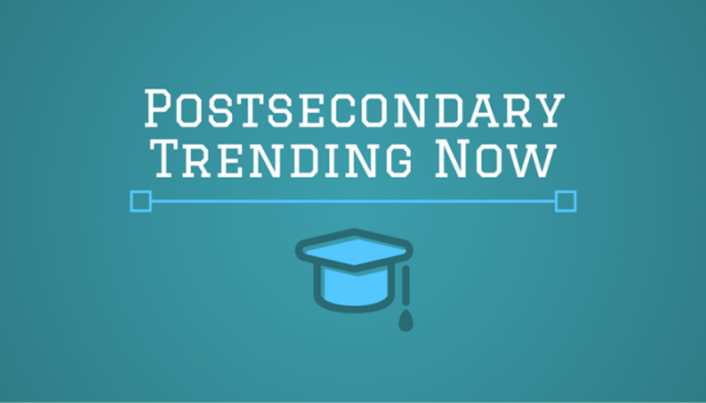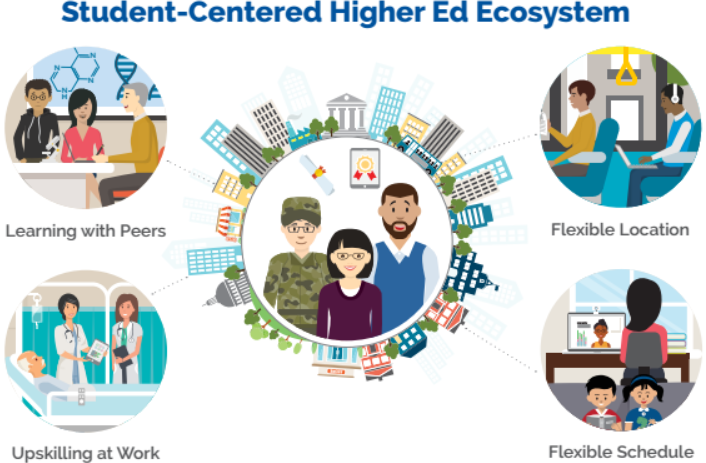
Higher education in the United States: It’s a system steeped in tradition. Its history predates the Constitution. Its reputation has led the world.
From the first colonial colleges to the growth of the university model, from land grant universities and the GI Bill to open access community colleges and distance education, the basic structures of a college experience have remained fairly constant. A student learns via a course that is created by and delivered by a faculty member, alongside a group of students, over a specific period of time, measured in semesters and credits and degrees.
New technologies — smartboards, CAD, learning management systems, e-portfoloios — have frequently entered this reliably staid system. They have been important. But they haven’t really changed those tried and true structures or impacted learning outcomes for students overall, have they?
People say these times are different. The new technologies that are shaping how we interact with others and consume information are transforming our lives, even how we think. And when it comes to higher education, so the argument goes, public confidence is waning. Its international standing is plummeting. Costs outweigh benefits. Outcomes are inconsistent, even opaque. Success is out of reach for too many.
Are the pressures on higher education today powerful enough to fundamentally shift the learning experience? In what ways might today’s technological advances reshape higher education as we know it? Will any new system of higher education be better than what our society has held in ivory towers for centuries?
The U.S. Department of Education Office of Educational Technology presents its own answers to these questions in its new report, Reimagining the Role of Technology.
At its core, the report advocates for a student-centered reimagining of the postsecondary ecosystem, with an integration of and collaboration between traditional institutions and a broader set of postsecondary learning providers. And much of this transformed system is enabled and enhanced by reimagining the use of technology.
Here’s why.
Nontraditional is the new black
The student body in higher education has been changing since colonial times, growing in number and becoming ever more diverse along many lines. And yet, our nation still has a hard time recognizing who our students really are. We continue to design and deliver and evaluate higher education for the typical student that is no longer typical. The ‘new normal,’ as the report refers to today’s students, is very different from the student body of yore. And the current system is not designed for these students.
Accept the things you cannot change
“It is impossible to redesign students to fit into a system, but we can re-design a system for students. This can be the difference between success or failure for our students that need the promise of higher education the most.”
—Joseph South, Director, Office of Educational Technology
I love this Joseph South quote in the report simply because it is so simple in its profound truth. While it’s daunting to take on system redesign, it really is the only option.
Times they are a-changin
The pace of change in our society has escalated and higher education is not set up to be nimble enough to keep up. This isn’t about “keeping up with the Joneses” as much as it is providing students with the education and preparation they need to thrive in much different conditions:
- A society that interacts almost as much online as it does on the ground
- A career that is less stable and more self-constructed with new professions never before imagined
- A culture that is more diverse, more global, and more interconnected

Student-Centered, Enabled by Technology
According to this report, technology has a big role to play to create a student-centered higher ed ecosystem. But only if we deploy it differently than we have in the past:
“However, for any technology solution to have a transformative impact on student learning and success, it must have as its foundation the specific goals, needs, and interests of the students themselves. While technology can be added to existing structures with the goal of making them marginally more efficient and flexible, technology also offers the opportunity to catalyze more significant reforms to educational structures and practices.” (p. 9)
To accomplish this vision of a tech-enabled student-centered ecosystem, the report identifies ten design principles and recommendations organized into five sections. Within each section, the report offers its perspective on the role of technology as well as examples of innovations, grounded in the design principles, that are in practice at colleges and universities today. Here I’ll share what most intrigued me from each section.
- Learning - Today’s students need lifetime learning and need to be able to access learning from multiple sources, not just the traditional two- or four-year college campus. Tech can help this ecosystem coordinate as well as document and recognize competencies developed through both formal and informal experiences.
- Teaching - The report argues for a team approach to teaching, that creating transformative learning opportunities for today’s students requires faculty, instructional designers, learning engineers, researchers, institutional data analysts, technologists, and learners themselves to work together.
- Assessment - “The science of assessment is underutilized in higher education,” claim the report authors. Tech can help provide and manage at scale more authentic assessments, assessments that provide frequent feedback, and more personalization. It can provide data on learning that all those collaborating on the teaching function (see #2 above) can use to improve teaching and learning.
- Support for Student Success - Tech can strengthen and sustain a complex, interconnected ecosystem that enables students to unbundle and rebundle an integrated, personalized learning path. Collaboration is a key factor, with calls for collaboration (a) between technologists, academics, and students, and (b) between institutions of higher education and other learning providers, like libraries and workplaces.
- Leadership for Innovation - This is where I think the U.S. Department of Education calls for the most challenging and most dramatic shift in our system of higher education. They recommend that higher ed leaders support a culture that embraces a student-centered vision as well as a penchant for innovation and change. The tradition and history and reputation of U.S. higher education built the current culture over centuries. How rapidly can higher ed respond?
Kristen Vogt is Knowledge Management Officer, NGLC (Next Generation Learning Challenges) at EDUCAUSE.
